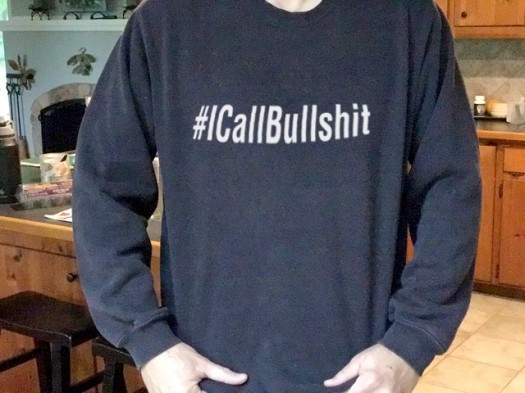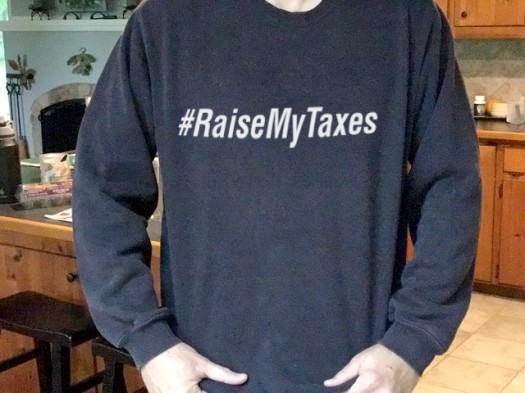A Placemaking Journal
‘So all we have to do is…’ call bullshit
 Chuck Marohn was in my town last week with his better-than-ever demonstration of the lies we tell ourselves about infrastructure finance.
Chuck Marohn was in my town last week with his better-than-ever demonstration of the lies we tell ourselves about infrastructure finance.
Chuck’s message and that of Joe Minicozzi prod us to get our arms around the math. And that’s a crucial message. But, jeez, our problem is way bigger. Thanks to the never-ending hangover from the 2016 campaign, we’re picking our way through fake news and alternative facts, hoping to salvage a morsel of hope that not everybody everywhere is bullshitting us about just about everything just about all the time.
The world is awash in bullshit. Politicians are unconstrained by facts. Science is conducted by press release. Higher education rewards bullshit over analytic thought. Startup culture elevates bullshit to high art. Advertisers wink conspiratorially and invite us to join them in seeing through all the bullshit — and take advantage of our lowered guard to bombard us with bullshit of the second order. The majority of administrative activity, whether in private business or the public sphere, seems to be little more than a sophisticated exercise in the combinatorial reassembly of bullshit.Chuck Marohn.
That’s from an intro to a new online course from the University of Washington, “Calling Bullshit”. That’s where we are. We need a for-credit course in BS detection at the college level. Also in elementary school, apparently, given this story on a successful experiment in introducing critical thinking in school children:
(The researcher’s) work brings us closer to answering that important question that haunted him — the one that should haunt all of us who care about evidence and facts: How do you prevent fake news and bullshit from catching on in the first place?
Yeah, how do you do that? How do you know when and how to abandon the polite response and just call fact-challenged assertions bullshit?
One clue that it’s time is when a proposed solution to a complex problem starts like this: “All we have to do is . . “
For example: If there are terrorists who claim they’re acting in accordance with their interpretation of a religious faith, all we have to do is assume everyone of that faith is a terrorist in waiting.

The author, rising to the challenge.
For those of us leaning even a little left, calling bullshit on that example is easy. But how ‘bout when the topics are related to transportation and land use planning?
If our roads are congested, all we have to do is add more lanes. If housing prices and rents soar beyond wage growth, all we have to do is bring the hammer down on developers to build what most folks can afford or build nothing at all. If well-heeled investors are gentrifying old neighborhoods, all we have to do is make it harder for them to disrupt places that should be preserved exactly as they are.
Listen to Dan Savage call bullshit on that line of thinking:
At roughly same time suburbanites got it into their heads that they’re entitled to drive through the center of the city at 70 MPH, urbanites got it into their heads that the center of the city is the cheapest place to live. (“Downtown, where the folks are broke!”) And for a while the center of the city was the cheapest place to live. But that’s no longer the case. Before we get to why downtown and inner-city neighborhoods are no longer the cheapest places to live, let’s pause to reflect on what made them the cheapest place to live for a good/depressing chunk of the 20th Century.
Downtown, the city center, close-in neighborhoods—for decades residential and commercial rents were low and you could find a giant loft space where you could make art (or drink about making art) or a cheap storefront where you could start a theater or a bar or a cult. But this was an historical anomaly driven by two things lefties hate: racism and the automobile. Shitty people abandoned the city: racist whites fled the city and expressways and cars made it possible for urbanophobes to exploit everything a city had to offer without having to actually live (and pay taxes) in the city. Once upon a time urbanites regarded this as a crisis. Today we rarely acknowledge the two social forces that made city centers the most affordable places to live: the evils of racism and the catastrophe of the automobile—hate, fear, and the internal combustion engine.
Savage is writing about Seattle, which is one of the North American nodes for both promulgating and denouncing bullshit. He’s calling out his tribe, progressives who’re often in the forefront of protests against inconvenient-but-potentially-successful adaptations to new urban realities:
We can shake our fists and put up posters—and refuse to make any actionable demands—but that’s not going to change anything or help anyone. Snark and pranks masquerading as activism aren’t going stop people from moving back into the cities. It’s time to do something that might actually make a difference.
What might that be? Scale up affordable housing programs mightily. Change zoning to guide development that delivers broad choice and opportunity instead of weaponizing it to block change. Go big on mass transit of all types, and subsidize it to make it an affordable, viable option for the most number of people.
The lefties in my tribe and in Savage’s would probably agree with a lot of that. We’re totally for investing in public services, especially with other people’s money. Where the passion drains from the conviction is the point where it’s our money, our time, our priorities for advocacy that have to align with what we claim are our values. Which means it’s fair to infer that a lot of the noise we make is, well, you know, bullshit.
We’ll be better positioned to refute the inference when we expand our advocacy to include this argument:

If PlaceShakers is our soapbox, our Facebook page is where we step down, grab a drink and enjoy a little conversation. Looking for a heads-up on the latest community-building news and perspective from around the web? Click through and “Like” us and we’ll keep you in the loop.



